First night in Quito, Ecuador, and already we've seen some of the country's natural beauty. Our flight got in from Houston at 10 pm, so we passed over the illuminated city as we touched down--strings of golden streetlights and houses that went on far longer than I expected. Quito is larger than I thought, but it is in a very confined valley between mountains. The airport is right in the center of the city for that reason, so when you're landing you fly by grocery and hardware stores not far from the runway!
Once we landed, Bruce and our Centro Magis colleague, Fernando, met us with a van and driver and a whole team of folks to help us bring all our luggage (camera equipment and all) to the hotel. It was a relief and a joy to see familiar faces in the crowd of the airport terminal, and to have such an easy, pleasant drive through the quiet Quito streets to our hotel.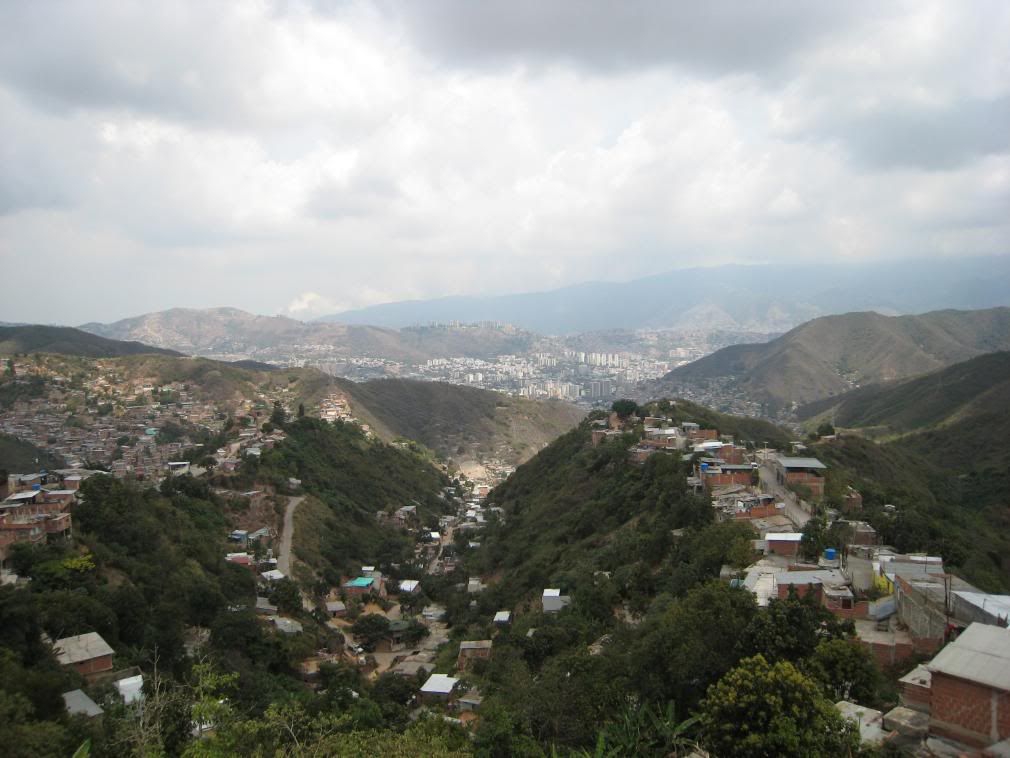
Tuesday, March 11, 2008
Arrival
Monday, March 10, 2008
An (almost) full day
So much happened today it's hard to keep it all straight. And yet, as our first full day in Quito, we took it fairly slowly and didn't have a heavy schedule. The thought of all the things we have planned for tomorrow is frightening...and terrifically exciting.
We started the day around 7:30 with a great breakfast at the Hotel Quito restaurant, then drove directly up to one of the highest points in the city-- "el Panecillo", a tall hill where an enormous statue of La Virgen de la Garda was erected in the early 1900s. From el Panecillo you have an astounding view looking down on the entire city of Quito, spread out through the valley and creeping up the sides of the surrounding mountains. Our videographer Patrick got some fantastic shots of the different neighborhoods and of La Virgen herself.
The only hurdle of the day happened on el Panecillo, where I got hit with a sudden and overwhelming case of altitude sickness. I had felt fine since arriving in Quito, as we stood watching a family fly their kites on the highest hill, a feeling of dizziness washed over me and I thought I was going to faint. The whole thing lasted about 20 minutes--Bruce had the driver pack us up and drive downhill immediately, and as soon as we got back to "lowland" Quito, I felt enormously better. Faintness and an upset stomach were my only symptoms, and no one else got sick, so all in all I think the altitude was not much of a setback.
The most interesting event was probably visiting our first Fe y Alegria school: "Escuela Afraser" in the eastern part of Quito. Normally we learned that it holds about 100 students from pre-school to 7th grade. As today is Sunday no regular classes were going on, but we were surprised to find that the school gets put to good use even on the weekends. We spoke to a few adults who come in every Saturday and Sunday for 4 hours of literacy training, as well as to a very young mother who attended a small weekend class to learn basic math and reading skills. The Fe y Alegria school is a beautiful oasis in a fairly dingy neighborhood, and provides education to a variety of people 7 days a week.
In case you're wondering what we all look like...
A shot of Patrick, Bruce, me and Fernando from left to right:
More pictures
Here are some photos of the first school we saw, Escuela Afraser:
The entrance to Escuela Afraser; there is a basketball court in the front and the building in back with the blue roof is the library:
Escuela Afraser also had a great-looking computer lab:
And these are some of the people we spoke with who were taking the adult literacy classes:

Saturday, March 08, 2008
Fe y Alegria
This morning we visited Padre Joseba Lazcano, the National Director of Fe y Alegria Ecuador. A warmer man you couldn't find--he was welcoming and open in the true Jesuit tradition. He and Bruce connected in particular and spoke a lot about FyA's latest initiatives, including the new campaign they are launching on April 25, "Compromiso por una Nueva Educacion". They are trying to start a region-wide movement that will truly improve public education systems, largely by using Fe y Alegria methodology.
 Later we visited Fundacion Esquel, the organization Bruce helped found with his friend Cornelio Marchan 18 years ago. We met Cornelio briefly, then had an extended conversation with Milton Luna and Dolores Padilla, the Esquel expert on education. They told us about what they do, and particularly about the civil society network that Milton leads, el Contrato Social. His dream is to get civil society really active in public education policy, and with their voice to influence the new Ecuadorian Constitution that is right now being re-written. Both Dolores and Milton seemed very eager to collaborate in future both with Magis Americas and Centro Magis, especially for a wave of publicity and activity they are planning for the week of April 25th.
Later we visited Fundacion Esquel, the organization Bruce helped found with his friend Cornelio Marchan 18 years ago. We met Cornelio briefly, then had an extended conversation with Milton Luna and Dolores Padilla, the Esquel expert on education. They told us about what they do, and particularly about the civil society network that Milton leads, el Contrato Social. His dream is to get civil society really active in public education policy, and with their voice to influence the new Ecuadorian Constitution that is right now being re-written. Both Dolores and Milton seemed very eager to collaborate in future both with Magis Americas and Centro Magis, especially for a wave of publicity and activity they are planning for the week of April 25th.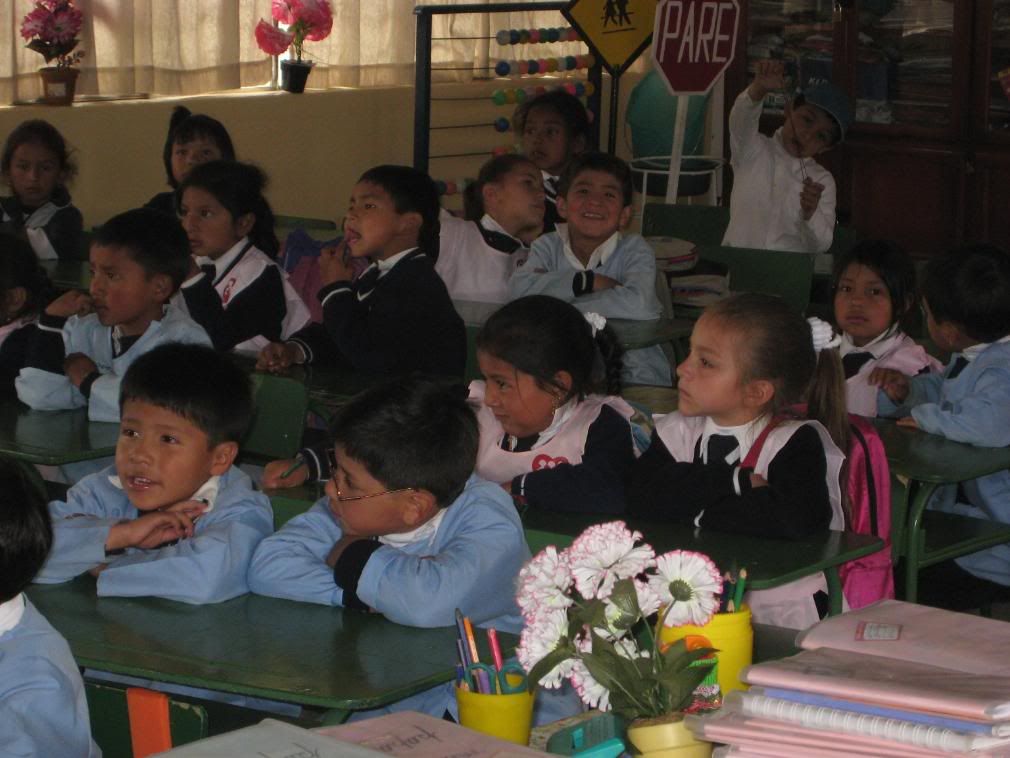 But best of all, by far, today was our visit to the Escuela Carlos Ponce Martinez, a school with about 700 students ranging in age from about 5 to 14 years. We got there as regular classes were ending, but in true Fe y Alegria style, the action doesn't stop at the end of the schoolday! We caught a performance of a short play put on by some of the older students, the tail end of a classroom lesson, and many extra-curricular programs that the school also runs. They have a garden out back where the students grow vegetables to sell and support their studies. They have a sewing studio for some of the mothers, where they sew uniforms and clothes to sell for personal income. They have a program for orphaned children, connected to the orchard, for which they raise money to support the children and help them finish their studies.
But best of all, by far, today was our visit to the Escuela Carlos Ponce Martinez, a school with about 700 students ranging in age from about 5 to 14 years. We got there as regular classes were ending, but in true Fe y Alegria style, the action doesn't stop at the end of the schoolday! We caught a performance of a short play put on by some of the older students, the tail end of a classroom lesson, and many extra-curricular programs that the school also runs. They have a garden out back where the students grow vegetables to sell and support their studies. They have a sewing studio for some of the mothers, where they sew uniforms and clothes to sell for personal income. They have a program for orphaned children, connected to the orchard, for which they raise money to support the children and help them finish their studies. The director of the school is a wonderful nun named Mother Carmen Pineda, a real lively and dynamic leader. She talked to us about how the school was formed 10 years ago, built by the whole community. The families all support the afterschool activities by buying their vegetables from the school and clothes from the mothers. She told us the sad but moving story of a girl whose father had died, and her mother became very sick. When her mother was close to dying, she came to Madre Carmen and asked her to take the girl in as a student, clearly because she felt safe leaving her child in the school's hands.
The director of the school is a wonderful nun named Mother Carmen Pineda, a real lively and dynamic leader. She talked to us about how the school was formed 10 years ago, built by the whole community. The families all support the afterschool activities by buying their vegetables from the school and clothes from the mothers. She told us the sad but moving story of a girl whose father had died, and her mother became very sick. When her mother was close to dying, she came to Madre Carmen and asked her to take the girl in as a student, clearly because she felt safe leaving her child in the school's hands. 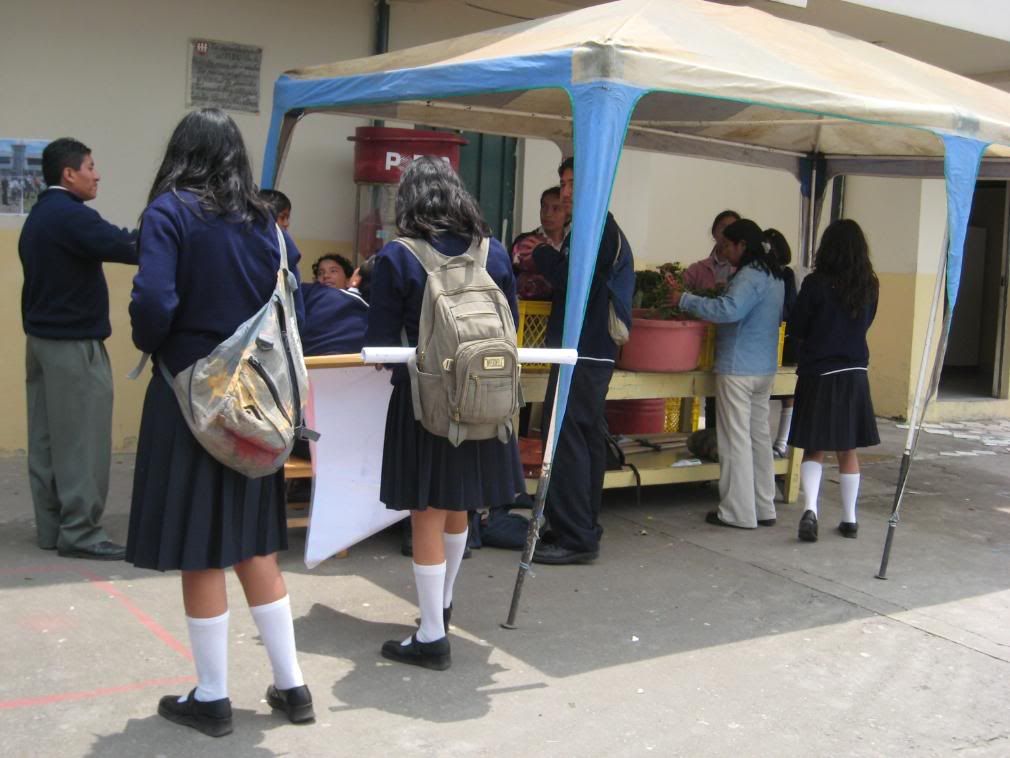 We also had a conversation/interview with several students and some teachers. Everyone seemed pretty comfortable, despite being on camera, and they had an amazing rapport. The computer teacher, Oscar, walked back to the school building with a group of students, talking and laughing the whole way, while Luis, the agriculture teacher, walked with his arm around a student as they talked about the interview. The children were all beautiful, healthy, and seemed very happy with their school. Some of them told their own personal stories, including the 9th grade class president Yajaira, a student in the orphaned children program who is being raised by her older sister (who is only 14). It was clear to see why she was the class president--she's a very smart and charismatic girl, and a favorite of Madre Carmen. You can see some of her story in our movie. We also got a chance to hear from most of the children about how they used computers and what they liked/didn't like about the school (likes: teachers, soccer field, classes; dislikes: gardening in the rain!, too few computers).
We also had a conversation/interview with several students and some teachers. Everyone seemed pretty comfortable, despite being on camera, and they had an amazing rapport. The computer teacher, Oscar, walked back to the school building with a group of students, talking and laughing the whole way, while Luis, the agriculture teacher, walked with his arm around a student as they talked about the interview. The children were all beautiful, healthy, and seemed very happy with their school. Some of them told their own personal stories, including the 9th grade class president Yajaira, a student in the orphaned children program who is being raised by her older sister (who is only 14). It was clear to see why she was the class president--she's a very smart and charismatic girl, and a favorite of Madre Carmen. You can see some of her story in our movie. We also got a chance to hear from most of the children about how they used computers and what they liked/didn't like about the school (likes: teachers, soccer field, classes; dislikes: gardening in the rain!, too few computers). I'd like to go on but the wonderful footage we took will tell the tale more fully than I could. All the teachers, Mother Carmen, and our team connected very well, and I think we are all hoping to be able to collaborate and support one another in the future.
I'd like to go on but the wonderful footage we took will tell the tale more fully than I could. All the teachers, Mother Carmen, and our team connected very well, and I think we are all hoping to be able to collaborate and support one another in the future.Friday, March 07, 2008
The Andes
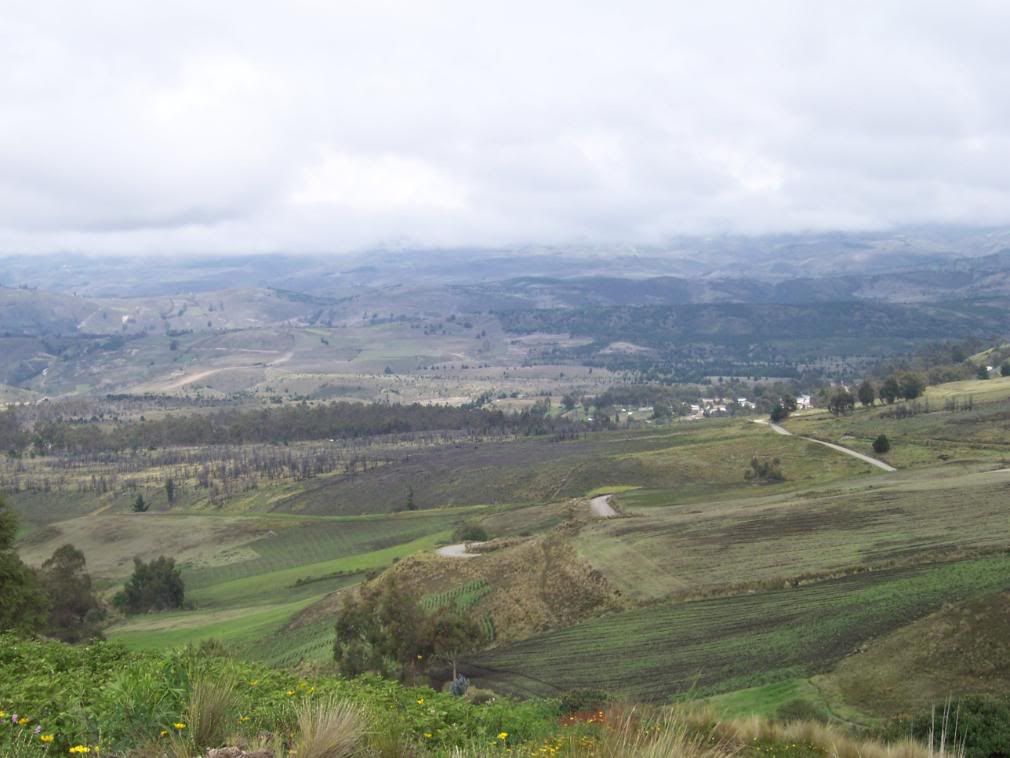 We visited a small school first with 25 indigenous students, overseen by the loving eyes of Padre Julio Galtaire. He has lived in the small town of
We visited a small school first with 25 indigenous students, overseen by the loving eyes of Padre Julio Galtaire. He has lived in the small town of We had to drive over potholed, partially flooded and unpaved roads, up a steep incline to the top of a mountain to reach it. Around us the
The school we went to was tucked into a little crevice in the mountain, half-hidden if approached from most angles. It had about 25 students and one teacher, and classes were fully bilingual, taught in Spanish and Quechua. Most of the boys wore red ponchos and the girls beige shawls and blue skirts, and all were exceedingly shy. They and the parents, who took shifts from farmwork to check on their kids, were smiling and welcoming, but so soft-spoken that conversation seemed impossible at first. But as we spent a good amount of time at this school, people began to open up to us (and us to them).
While at the school we sat in on some classes, and the children taught us many phrases in Quechua-- yuppay chani, for thank you. Alli pancha, for good day. Then Bruce got up and taught them to say 'good day' in English, then I went to the front of the class to teach 'bonjour,' and Fernando went up there to teach 'gutentag.' It was a tremendous and fun exchange that I think everyone enjoyed.
 The location, the children, the language--all were stunning and so unlike anything I had ever encountered. Who among us expects to travel through the Andes and learn Quechua, or to meet with people who wear red ponchos and long skirts and intricate necklaces not as a gimmick, but because that's the way their parents and grandparents and great-grandparents dressed, and they see no reason to change?
The location, the children, the language--all were stunning and so unlike anything I had ever encountered. Who among us expects to travel through the Andes and learn Quechua, or to meet with people who wear red ponchos and long skirts and intricate necklaces not as a gimmick, but because that's the way their parents and grandparents and great-grandparents dressed, and they see no reason to change?The people we met are very poor. As Padre Julio said, their way of life is rich in tradition and culture, and this must be preserved. We don't want to inundate them with Western practices and invade their culture. But they do crave education and better schools and help selling their products, because they seek social mobility. Survival is a struggle, and this is why we need programs like the bi-lingual, bi-cultural schools run by Fe y Alegria. With DVD players and projectors, they can use the best courses available to teach their children Spanish. With more school supplies, computers and books, they can teach both kids and parents to read, and allow them to make themselves known to the government. There is a tendency in Ecuador to forget about the indigenous people. But with the power of expression through literacy, and connection through internet, they can escape their marginalization and save their culture from a slow disappearing act.
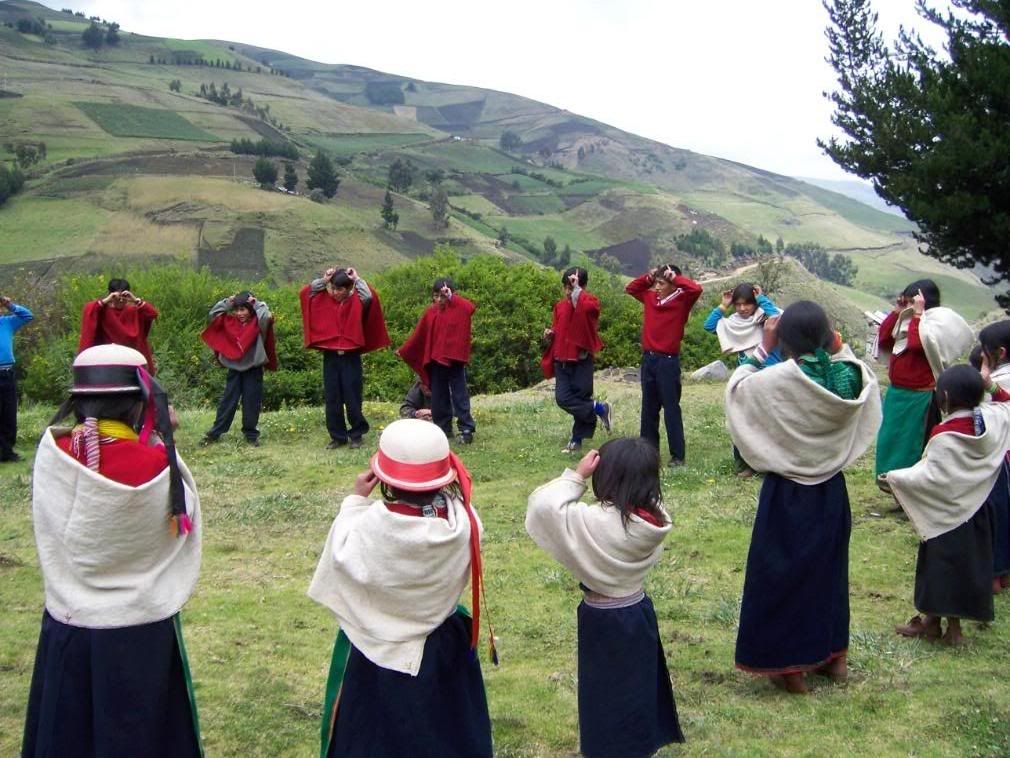
Thursday, March 06, 2008
Caracas
Caracas is a world apart from Quito. Instead of 17th century mansions and churches surrounded by a sea of two-story cement homes, we have 20-story office buildings, billboards and shopping malls. A single, mad highway choked with traffic runs through the center of the city, and the small mountains that ring it are covered in slums. These are true slums—tin shacks, squatters in dilapidated and abandoned one-story homes, stolen electricity and water, and violence.
Mostly just travel today. Ecuador to Colombia to Venezuela, which made us nervous due to the current tensions after Colombia's recent military incursion onto Ecuador territory. Luckily the wonders of capitalism kept our flights running without a hitch. The rides were short and pleasant, the security easy as pie (except in Colombia there was quite a large amount of soldiers in military garb around the airport). Several soldiers were sitting in front of a TV watching Hugo Chavez accuse Alvaro Uribe, their president, of being a liar, which was rather chilling.
Tomorrow we visit our first high school. I’ll check in then.
Technical Training
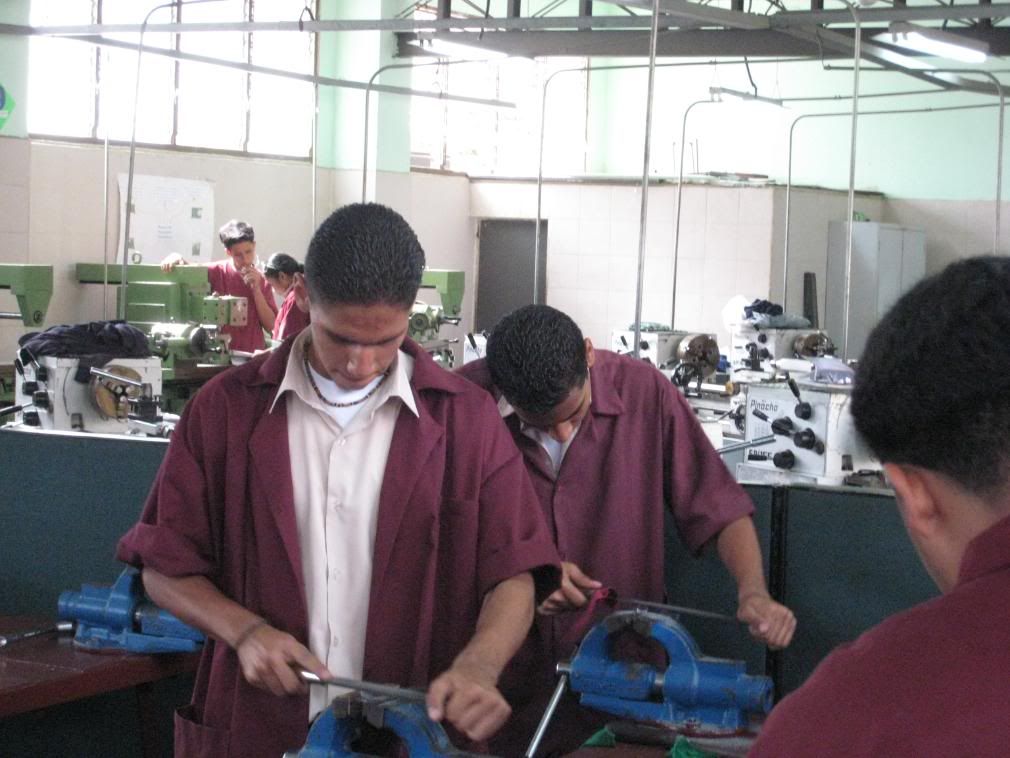
We started in a new slum today, Antimano, which covers the mountain directly behind Padre Ugalde's university. "Instituto Tecnico Jesus Obrero" trains students to become industrial workers, creating metal and plastic machine parts. It may not seem like an ambitious goal, but many of these students live in the barrio and have dropped out of school. If they go to a school like this to get their high school degree and then additional technical training, they'll have lots of jobs open to them and skills for a good income. Many of these students also go on to university.
The equipment they have at the school is first-rate. Bruce and a teacher told me that in many schools, students just see pictures of the machines that these kids were practicing on. They had a hydraulics lab, brand new appliances that they put together and take apart, and were constructing two floors of new classrooms. The school's director, Padre Carlos--a priest, not a Jesuit--is a real dynamo from Spain. He has been incredibly active on behalf of the school, getting funding for them from various corporations, the Spanish government, and more entities. The school would not be able to function if not for his constant fundraising on top of his regular duties.
The rest of the day we spent at Padre Ugalde’s university, Universidad Catolica Andres Bello, and at the Centro Magis office. The university is really gorgeous, equally large, developed and landscaped as many American colleges. We visited in-between semesters, but there were still plenty of students walking around, lounging on the lawns in groups, playing guitar, etc.
 We also met with the folks from AUSJAL, the Association of Jesuit Universities in Latin America, and strengthened that relationship somewhat, as well as ironed out some projects that we might help them with.
We also met with the folks from AUSJAL, the Association of Jesuit Universities in Latin America, and strengthened that relationship somewhat, as well as ironed out some projects that we might help them with.Wednesday, March 05, 2008
Project Information
The high school we visited today, Andy Aparicio, was actually less interesting than some of our other visits. We started at a lower school, Escuela Jose Maria Olaso, in a poor slum called La Vega. At this school the love between teacher and student that we wanted to catch on camera was plain to see. The teachers dress casually and engage their students on a friendly level, as does the woman we interviewed, Nelly Monsalde, the school's pastoral director. She is considered a pillar of the school, and seems to know all 674 students by name.
Bruce was impressed with the classroom values that were posted everywhere--rules about tolerance, working together, paying attention, etc. I think much of this was Nelly's influence, as she really inculcates what she calls "Christian humanistic values" in all areas of study and school life. This moral basis seems to be the strength of Fe y Alegria schools. Everyone we have met with emphasizes it.
This is the area just outside Escuela Jose Maria Olaso:
In contrast, these are children inside the school grounds:
We later spoke with German Garcia Velutini, the head of a large Venezuelan bank who is on the Fe y Alegria national board. He said that his HR department is always looking for Fe y Alegria graduates for entry-level jobs! It's not because they're smarter but because they are more responsible, and have a moral foundation that makes them better employees. The vice-principal of the high school we visited explained that this is a key focus of her school-- they teach children to be fully-developed human beings, and pay attention to the whole student, not just to his studies.
I think we can do seriously good work on a small scale for these schools. We can connect donors on a personal level to these locations, and present concrete ways they can help a specific school. Bruce got the idea while talking to German of having Jesuit or Catholic lower schools in the States hold raffles--the students can sell tickets, and someone can donate the prizes-- to benefit FyA.
We're both looking forward to getting this DVD put together and to putting the extra footage to good use--website, special project DVDs, etc. Already it has been a fruitful trip.
Tuesday, March 04, 2008
Dominican Republic
I'm afraid that our first impression of DR has not been too impressive. We arrived after a short, low-flying flight on an outdated plane, then passed through what can only be called a very selective security check. We got through and luckily found our driver, a real talkative character who only goes by the name "Waris." By the time we reached the hotel he had told us about all the candidates in the upcoming presidential elections, the histories and differences of their various parties, and the colors associated with each one.
Along the way we passed a rednecking traffic jam; a pedestrian had tried to cross the highway (as they frequently do) and some cars and people had gathered around an ambulance. The man lay dead on the asphalt, covered in a sheet of cardboard. I was brought back to images of New Orleans post-Katrina. Also like New Orleans, Santo Domingo is very underdeveloped, with small, one-story houses, unkempt plant growth, and many unpaved roads.
Santo Domingo seems like a tough place.
Monday, March 03, 2008
The real DR
 DR really came to life for us today. We started with a quick filming of families coming out from church today. Then we drove around for a while, trying to find a good location for filming some of the poorer neighborhoods.
DR really came to life for us today. We started with a quick filming of families coming out from church today. Then we drove around for a while, trying to find a good location for filming some of the poorer neighborhoods. We ended up in a large barrio near the main airport. Along the highway it doesn't look so bad--the streetside row of buildings are small and a bit run down, but mostly they're of a middle working class. Then we drove in further, away from the highway, and all of a sudden it's like rural Belize. Streets are unpaved, rocky dirt roads, the houses are dilapidated tin and wooden huts, and children run around half-dressed, not attending school. It was probably one kilometer from the main highway, but as the folks we spoke to said, they were a forgotten community.
We ended up in a large barrio near the main airport. Along the highway it doesn't look so bad--the streetside row of buildings are small and a bit run down, but mostly they're of a middle working class. Then we drove in further, away from the highway, and all of a sudden it's like rural Belize. Streets are unpaved, rocky dirt roads, the houses are dilapidated tin and wooden huts, and children run around half-dressed, not attending school. It was probably one kilometer from the main highway, but as the folks we spoke to said, they were a forgotten community.First we spoke to some mothers and their two daughters, who were all sitting on the front porch of their one-story wooden house. We interviewed the girls and learned that they want to be doctors when they grow up, and that they like their public school but wish it were closer to home. Their mothers told us that though their sons are six and seven years old, they don't go to school yet because the distance is too far to walk alone. They also complained that the teachers are poorly trained and often don't show up to school, so kids are just sent home.
As we walked further into the barrio and encountered worse "streets" and houses, we met up with a young man named Juan Benitez Valdez. He was understandably bitter and angry at the situation of his neighborhood, and spoke very eloquently about the changes they needed. We weren't too surprised, after hearing him talk, to learn that his brother is the head of the neighborhood community association that is trying to improve their area, La Caleta. Juan brought us to his brother and we interviewed both of them. You can see both of them speak in our movie.
 I think all of us were inspired by their drive and hard work, and by the way that everyone in La Caleta has a very constructive and determined outlook. We're going to put them in contact with Humberto Vandenbulcke, the head of DR's Fe y Alegria. We think their association could benefit from and contribute to the international Compromiso por la Educacion, a campaign and network that comprises a variety of nonprofits. I think we'll also add them to our own project list.
I think all of us were inspired by their drive and hard work, and by the way that everyone in La Caleta has a very constructive and determined outlook. We're going to put them in contact with Humberto Vandenbulcke, the head of DR's Fe y Alegria. We think their association could benefit from and contribute to the international Compromiso por la Educacion, a campaign and network that comprises a variety of nonprofits. I think we'll also add them to our own project list.After the heaviness of the morning's visit (and the intense pace of the prior week), we decided to break for a couple of hours. We had a Dominican-style lunch, eaten outside off of shared platters-- a great grilled whole fish that we picked to pieces, fried chicken, fresh avocado...it was just delicious. Then we took an hour to hit the beach and swim in the absolutely perfect Caribbean.
 All in all, I think I've fallen in love today--with the ever-present, loud Dominican culture and music, with the brothers Benitez who are changing their community, and with the amazing beach that's five minutes from the city. The only thing that throws me off is DR's Columbus cult--there are statues of him and plazas named after him. It's wild, considering his arrival was so harmful for the island. It may be this same mentality that allows for a community of Dominicans to be forgotten, even as it sits--as Juan said-- right next to the airport, the first thing visitors see as they enter the country. If you recall my entry from yesterday, my first impression certainly wasn't too positive.
All in all, I think I've fallen in love today--with the ever-present, loud Dominican culture and music, with the brothers Benitez who are changing their community, and with the amazing beach that's five minutes from the city. The only thing that throws me off is DR's Columbus cult--there are statues of him and plazas named after him. It's wild, considering his arrival was so harmful for the island. It may be this same mentality that allows for a community of Dominicans to be forgotten, even as it sits--as Juan said-- right next to the airport, the first thing visitors see as they enter the country. If you recall my entry from yesterday, my first impression certainly wasn't too positive.Maybe we can convince the Minister of Tourism to help them out.
Colors of DR
 Later we visited another school in a really tough neighborhood, the first FyA school in the country. One of the sisters showed me the school history through its 27-year photo album, and I saw how students and family members all contributed to its construction and constant expansion. The students have built their own outdoor clubhouse and theatre, and they also all rotate chores to clean the entire school. We visited some classrooms with kids ready to graduate high school, some technical training workshops, and held interviews with the director and some students. The school, though in a poor and crime-filled area, seems to be doing a really good job--they have a low attrition rate, and both students and the director said that graduates get very good jobs.
Later we visited another school in a really tough neighborhood, the first FyA school in the country. One of the sisters showed me the school history through its 27-year photo album, and I saw how students and family members all contributed to its construction and constant expansion. The students have built their own outdoor clubhouse and theatre, and they also all rotate chores to clean the entire school. We visited some classrooms with kids ready to graduate high school, some technical training workshops, and held interviews with the director and some students. The school, though in a poor and crime-filled area, seems to be doing a really good job--they have a low attrition rate, and both students and the director said that graduates get very good jobs. We also visited the national FyA office and interviewed Humberto, and got a great interview from Jorge Cela, the director of the international federation of FyA. He gave us some great soundbites and Humberto gave us some great leads on collaboration, so it was an overall good visit.
We also visited the national FyA office and interviewed Humberto, and got a great interview from Jorge Cela, the director of the international federation of FyA. He gave us some great soundbites and Humberto gave us some great leads on collaboration, so it was an overall good visit.Sunday, March 02, 2008
Last night
 Bruce and I are really, really satisfied with how this trip turned out. Aside from one small hotel mix-up, we avoided big snafus and had a largely smooth trip. We visited plenty of schools and have a large portfolio of projects that we can present to potential donors and foundations. We also have enough first-rate footage to make about a dozen short films. I can't wait until we have the first finished product, and can then move on to creating DVDs for specific projects, putting school tours and interviews on our website, and so on. Those 18 hours of footage will be an incredible tool for our work as we move forward.
Bruce and I are really, really satisfied with how this trip turned out. Aside from one small hotel mix-up, we avoided big snafus and had a largely smooth trip. We visited plenty of schools and have a large portfolio of projects that we can present to potential donors and foundations. We also have enough first-rate footage to make about a dozen short films. I can't wait until we have the first finished product, and can then move on to creating DVDs for specific projects, putting school tours and interviews on our website, and so on. Those 18 hours of footage will be an incredible tool for our work as we move forward.



